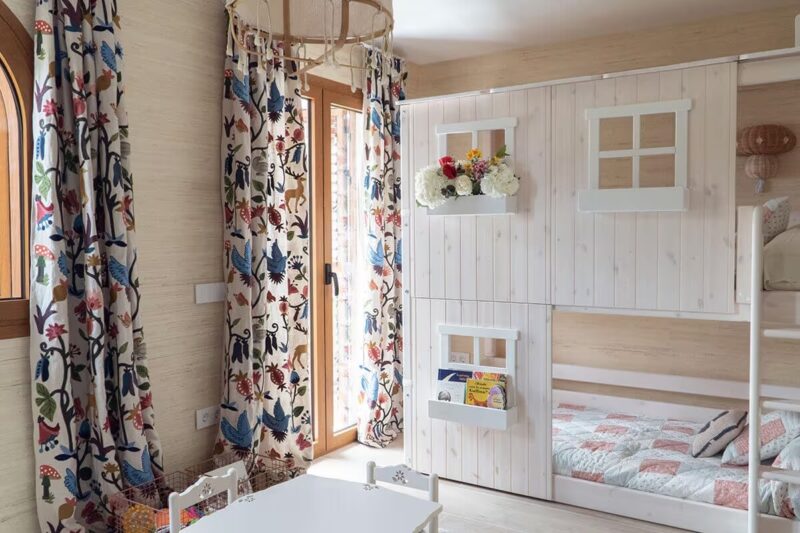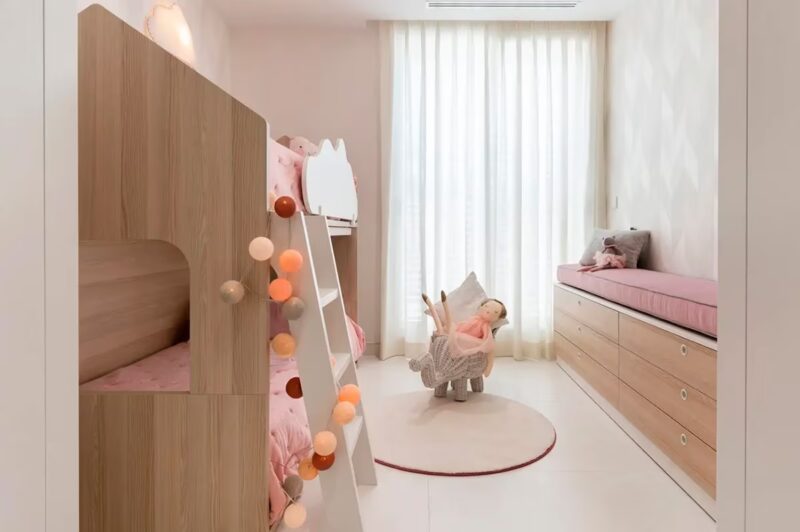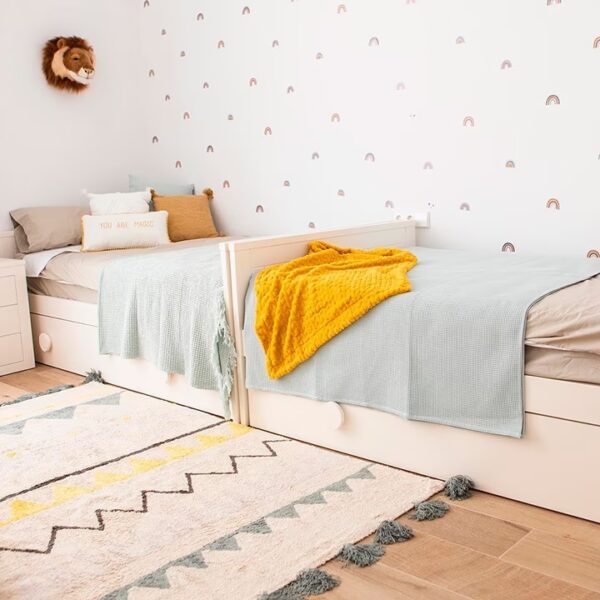Creating a space that is safe, inspiring, fun and practical is a real challenge when it comes to decorating children’s rooms
For decorated children’s rooms, we have put together an ultimate guide. We are going to tell you the dos and don’ts that you should take into account when designing a space for your children. These children’s room ideas range from a baby’s bedroom to the teenage years.
The early years are the most important for a child’s emotional and cognitive development. And the bedroom is a room where they spend and will spend a lot of time playing, reading and sharing unforgettable moments. It is therefore important that the space helps to stimulate the senses and create a sense of wonder.

Par-ker® Manhattan Maple, from Porcelanosa
Children’s rooms with a vision of the future
If you choose wisely, the bedroom design should be adaptable at every stage: infancy, pre-adolescence and adolescence. And beyond. Let’s explore decorated children’s rooms: furniture, finishes and accessories… All these elements will ensure that the space is adaptable and durable.
It is clear that a young child’s bedroom is not going to be the same as a teenager’s bedroom. Their needs and priorities change throughout childhood. However, there are some basic elements that remain constant. One of them—and the most important—is to create the optimum conditions for a restful night’s sleep.
Children spend a lot of time in their rooms, mainly because they need more sleep than adults. And secondly, because more activities can take place in these spaces: feeding, playing, story time or studying.
The most important practical aspects we will explore in this article on children’s room décor are as follows:
- Finishes: children’s bedrooms need durable and strong finishes to withstand wear and tear. This is an opportunity, not a problem for decoration.
- Storage: to promote tidiness in children’s bedrooms from an early age. Wardrobes, boxes and different storage modules for keeping toys.
- Furniture: not only the bed, but also desks (for the teenager), seating, shelves, etc. Furniture has a practical and decorative function.
- Lighting: enhance natural light to make the most of it. Enhance with artificial lighting when necessary.
Ideas for decorating children’s rooms
Forget about clichés: blue for boys and pink for girls. Better to go for more tactile wall finishes with textures that will give personality to children’s rooms. Bright colours, wallpaper with patterns or pictures, and textured wall coverings will stimulate the baby or child.
Here are some floor and wall options for decorating children’s rooms:
- Washable wallpaper is a great solution for the walls of a small child’s bedroom. Their easy cleaning makes them easy to maintain. L’Antic Colonial vinyl cladding is another great choice.
- Vinyl is practical, warm and attractive. A wood effect vinyl floor or similar finish is hygienic and easy to maintain.
- Ceramics are a great alternative for floors and walls. There are a multitude of designs and tones. If you opt for a neutral colour and effect, you’re sure to get it right.

Skins Pattern Dreamland Rose, from L’Antic Colonial.
Ideas for decorating a child’s bedroom
The number one priority in children’s bedrooms is play, which is essential for their development in the early years. For children, everything is a game. Storage capacity, strength of materials and adaptability of space are some of the key factors.
From a very young age, children are autonomous beings, and they need space to express themselves. One way of creating this mood is to use chalkboard paint for part of the wall. Combine with wallpaper to add light and colour to the room.
Furniture is part of the décor of a child’s room. The bed is the starting point for small and large children’s bedrooms. This piece of furniture can transform into a magical sailing boat, a space rocket or an over-sized doll house. Don’t forget that children are small people. As a result, the perception of the dimensions and perspective of a room is different from that of adults.
Important: in decorated children’s rooms, we need to be careful with sharp edges on furniture, windows, curtain pulls, electrical sockets, etc.
Tips for decorating pre-teen bedrooms
In the pre-teen years, children begin to make their own decorative choices. This means that children’s bedroom ideas must be tailored to the needs and tastes of the child.
If two or more pre-teens share the same bedroom, we recommend defining the spaces for each one. Use beds, shelves and any other furniture to create two (or more) defined areas. Bunk beds are a good option. If another bedroom is available in the future, the area underneath can easily be transformed into a study space.
The décor for a pre-teen should include references to hobbies and past-times. You can allocate a corner of the bedroom to a musical instrument, or place shelves to display trophies or hobby items. To do this, use a neutral colour palette. At the same time, invest in good flooring, which, with its strength and design, elevates the interior design of the room.

Bottega Caliza, from Porcelanosa.
Ideas for teen bedrooms
The main difference between bedrooms for teenagers and other childhood stages is that young people actually live their lives there. So, it is best to treat the space as if it were a mini-apartment.
Adolescents seek and want privacy, which is normal for their age. Adding a seating area to the bedroom with pouffes will give it that youthful touch. This will give children a place to hang out with their friends in a relaxed setting. When the dimensions are small, take advantage of any available height to double the space. We are no longer talking about a small children’s room, but a youthful bedroom where the space has been maximized.
All the decoration for a youthful bedroom
Textiles, bedding, rugs and curtains are elements that can brighten up the most boring room. Along with lighting, these accessories are simple and affordable to change as children grow up.
Prints are a way of stimulating the imagination. Make up for the lack of natural light in a dark bedroom with bold colours and patterns. Choose a thick lining for window curtains to ensure total opacity during summer nights. Just as decoration can stimulate a child’s imagination, so can light. Lighting transforms spaces.
Tip: to make bedtime stories more fun and exciting, use a lantern or galaxy-effect lamp.
Furniture for children’s bedrooms
In children’s bedrooms, the furniture has a multitude of functions depending on the age of the child. Furniture defines the boundaries of the child’s personal space and becomes more important.
In addition to stimulating play, the various elements of children’s bedroom furniture are used to maintain tidiness, concentration and privacy. The following elements will repay your initial investment over the years:
- Bed: the most important piece of furniture in a child’s bedrooms is the bed. Nowadays, there are furniture systems that can adapt the bed from infancy to adolescence.
- Desk: invest in a quality desk that encourages concentration, is comfortable and the right size for the room.
- Storage drawers: even if it’s a bit of an uphill struggle, make tidiness attractive with storage furniture.
- Children’s bedside table: if it can be combined with the bed, all the better. Calculate the right height of the desk so that the youngest members of the household can use it comfortably.
- Shelves: as children grow up, they will need more shelves. In addition, children will learn to be tidier if they have the storage space to allow them to do so.

Par-ker® Ascot Arce, from Porcelanosa.
In short, designing children’s rooms is a journey full of creativity. From the early years at pre-school to the pre-teen and teen stages, we have tried to give you some ideas in our guide. This way, you will transform your child’s space into a place of wonder and comfort.






